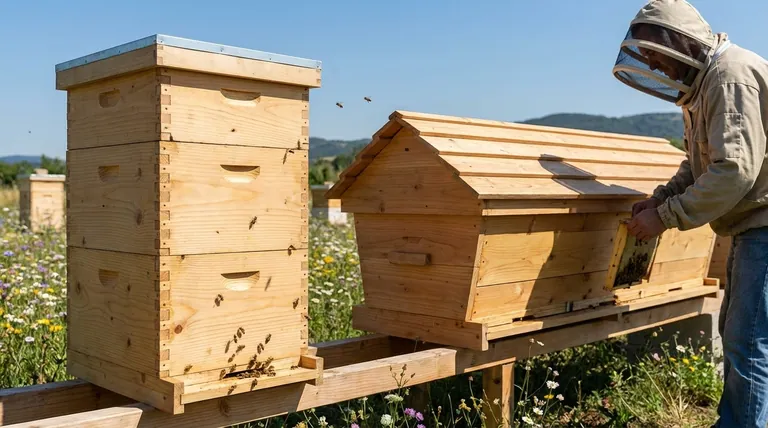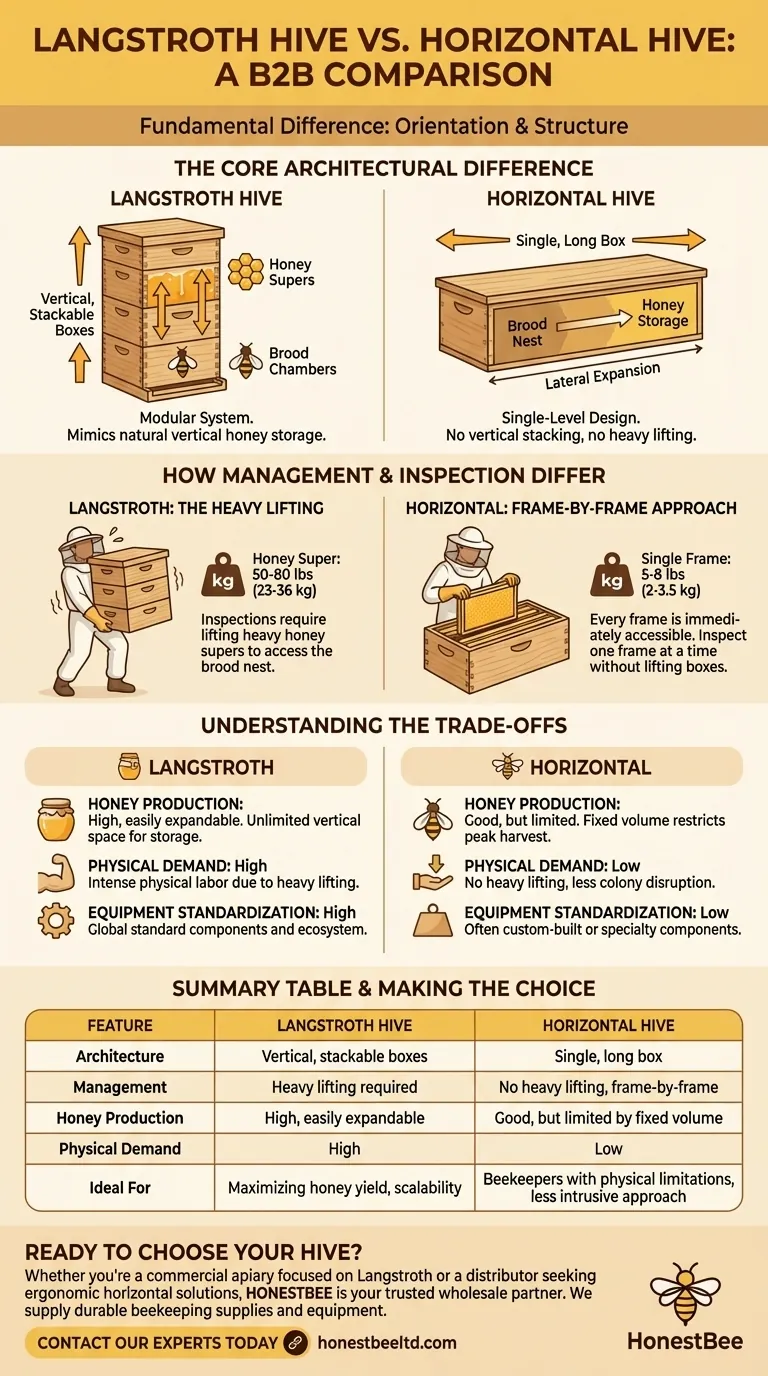At a fundamental level, the difference between a horizontal hive and a Langstroth hive is its orientation and structure. A Langstroth hive is a vertical, modular system of stackable boxes, while a horizontal hive is a single, long box that expands sideways. This core architectural difference dictates every aspect of how you will manage your bees.
The choice between a vertical Langstroth and a horizontal hive is not about which is "better," but which best aligns with your personal goals. Langstroth is designed for scalability and maximizing honey production, while horizontal hives are designed for ease of physical management.

The Core Architectural Difference
The shape of the hive is the most obvious distinction, and it has profound implications for how the bee colony organizes itself and how you interact with it.
The Langstroth Hive: A Vertical Design
The Langstroth is the global standard for modern beekeeping. It consists of multiple boxes stacked on top of each other.
The bottom boxes, or brood chambers, are where the queen lays her eggs and the colony raises its young.
The upper boxes, known as honey supers, are where the bees store surplus honey. This vertical stacking mimics a bee's natural tendency to store honey above the brood nest.
The Horizontal Hive: A Single-Level Design
Horizontal hives, such as the Top-Bar or Long Langstroth, are contained within one long box. There is no vertical stacking and therefore no heavy lifting of hive components.
The colony starts at one end and expands sideways as it grows. The brood nest occupies a section of the frames, and honey is stored on the frames farther away from the entrance.
How Management and Inspection Differ
Your day-to-day experience as a beekeeper is defined by how you inspect the hive. This is where the two styles diverge most significantly.
Inspecting a Langstroth: The Heavy Lifting
To inspect the health of the brood nest in a Langstroth hive, you must first lift off all the honey supers stacked on top of it.
A single honey super full of honey can weigh between 50 and 80 pounds (23-36 kg). This makes inspections a physically demanding task.
Inspecting a Horizontal Hive: A Frame-by-Frame Approach
In a horizontal hive, every frame is immediately accessible after removing the lid. You inspect the hive one frame at a time, without ever needing to lift a heavy box.
An individual frame of honey or brood weighs only 5 to 8 pounds (2-3.5 kg), making this design ideal for anyone with back problems or limited physical strength.
Understanding the Trade-offs
Choosing a hive system involves balancing honey production potential against the physical demands and management philosophy.
Honey Production and Expansion
The Langstroth's modularity is its greatest strength for honey production. During a strong nectar flow, you can keep adding supers vertically to provide nearly unlimited space for honey storage.
A horizontal hive has a fixed volume. While it can produce a substantial amount of honey, it cannot be expanded in the same way, potentially limiting the peak harvest from a single hive.
Physical Demands and Colony Disruption
The primary trade-off for the Langstroth's high yield potential is the intense physical labor required to manage it.
Conversely, the horizontal hive's primary benefit is the elimination of heavy lifting. This also results in less disruption for the bees, as you only disturb the specific frames you are inspecting rather than breaking the entire hive apart.
Equipment Standardization
Langstroth components are standardized worldwide. You can buy boxes, frames, and tools from any supplier, and they will work together.
Horizontal hives, particularly Top-Bar hives, are less standardized. While Long Langstroth hives use standard Langstroth frames, the hive bodies are often custom-built or sourced from specialty suppliers.
Making the Right Choice for Your Goals
Your decision should be a direct reflection of what you want to achieve with beekeeping.
- If your primary focus is maximizing honey production: The Langstroth hive is the industry standard for a reason; its expandability is unmatched.
- If your primary focus is minimizing physical strain: The horizontal hive is the undisputed winner, transforming beekeeping into an accessible activity for everyone.
- If your primary focus is a less intrusive, "bee-centric" approach: The horizontal hive allows for calmer, more targeted inspections that are less disruptive to the colony.
- If your primary focus is readily available equipment and resources: The Langstroth hive has a massive ecosystem of suppliers and educational materials.
Ultimately, the best hive is the one that keeps you engaged and excited about the craft of beekeeping.
Summary Table:
| Feature | Langstroth Hive | Horizontal Hive |
|---|---|---|
| Architecture | Vertical, stackable boxes | Single, long box |
| Management | Heavy lifting required | No heavy lifting, frame-by-frame |
| Honey Production | High, easily expandable | Good, but limited by fixed volume |
| Physical Demand | High | Low |
| Ideal For | Maximizing honey yield | Beekeepers with physical limitations, less intrusive approach |
Ready to Choose Your Hive?
Whether you're a commercial apiary focused on maximizing honey production with Langstroth hives or a distributor seeking ergonomic horizontal hive solutions, HONESTBEE is your trusted wholesale partner. We supply the durable beekeeping supplies and equipment you need to succeed.
Contact our experts today to discuss your specific needs and discover how we can support your beekeeping operations with high-quality, reliable equipment.
Visual Guide

Related Products
- Langstroth Bee Hives Bee Keeping Box for Beginners Beekeeping
- Long Langstroth Style Horizontal Top Bar Hive for Wholesale
- HONESTBEE Professional Multi-Functional Hive Tool with Ergonomic Wood Handle
- Multi-Functional Sliding Hive Entrance for Beekeeping
- HONESTBEE Advanced Ergonomic Stainless Steel Hive Tool for Beekeeping
People Also Ask
- Why are Langstroth hives recommended for beginners? Unmatched Support & Standardization
- Why might a beginner be advised to start with a Langstroth hive? Unlock a Supportive Beekeeping Ecosystem
- What basic equipment is needed to start beekeeping? Your Essential Guide to a Confident Start
- What is the best type of bee hive for beginners? Start with the Proven Langstroth Standard
- How does the orientation of the hive sides benefit comb construction? Ensure Straight, Movable Combs for Easier Hive Management



















